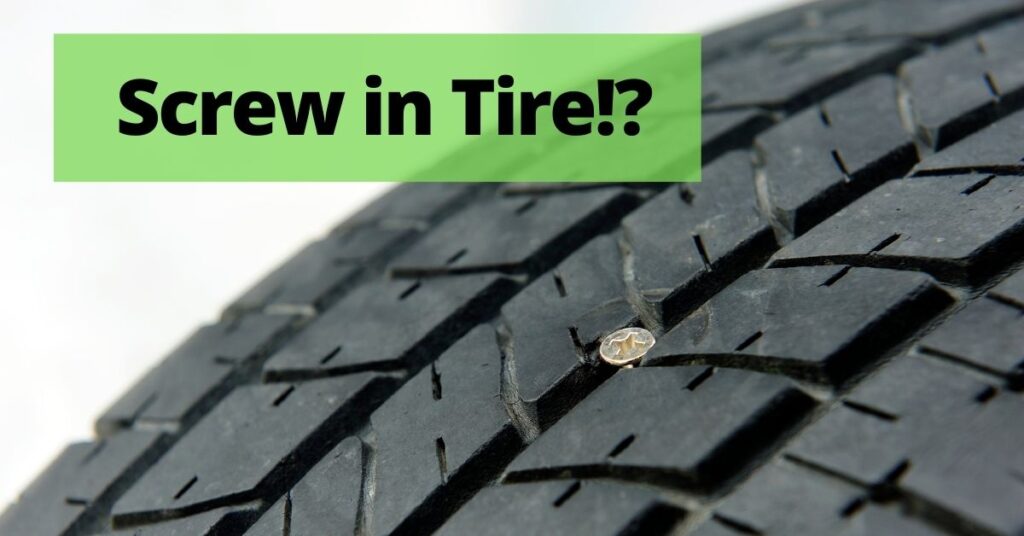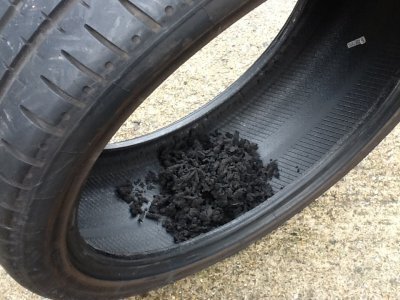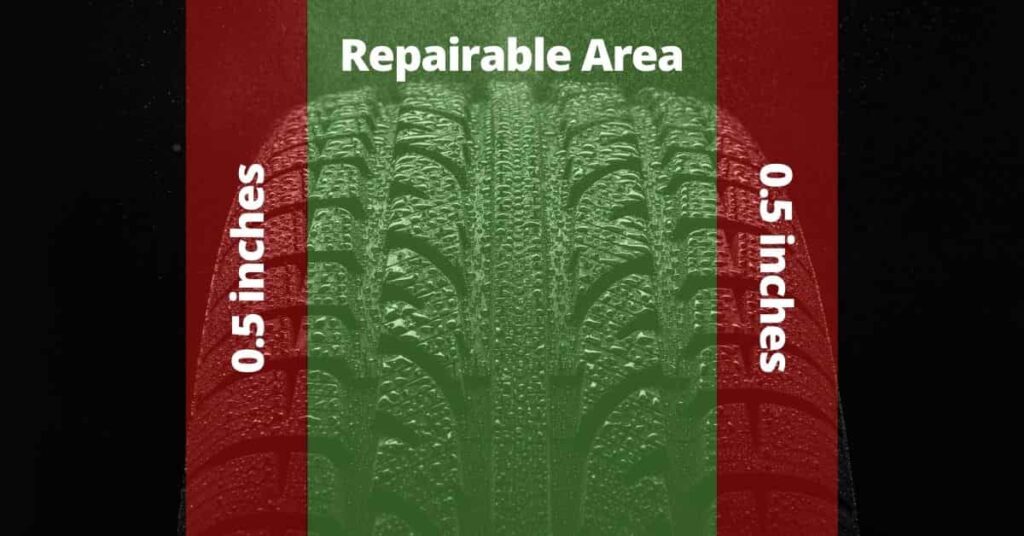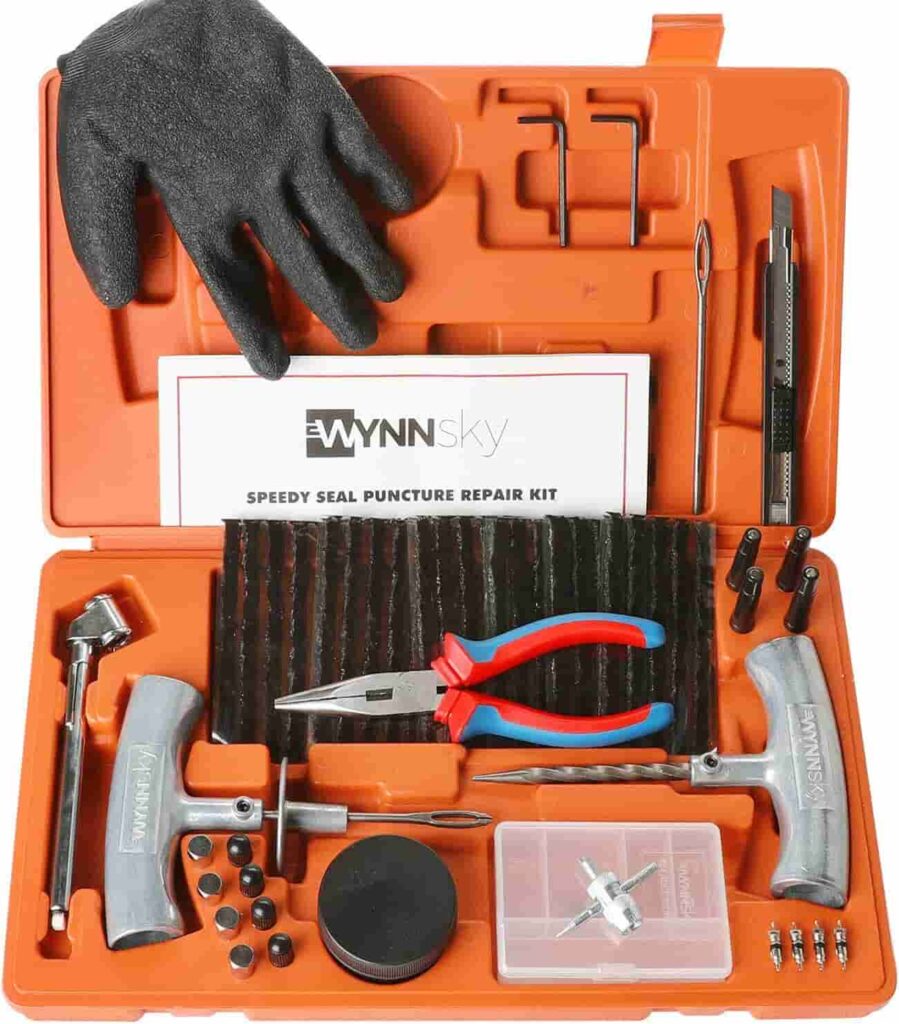Having a screw in your tire is never a good thing. No matter what, you’re going to need to take action.
The options you will have are to:
- Change the tire
- Replace the tire
- Patch the tire
- Plug the tire
You may be reading this because you discovered this from low tire pressure, you happened to see it while you were parked, or you have a flat tire.
In all of these cases, the best thing to do right away is to change the tire and put the spare on.
After changing the tire, our recommendation is to take it to a tire center to be evaluated for permanent damage and possible fixes.
In the rest of this article, I will describe the pros and cons of each method as well as general guidelines for repairing a tire from a screw.

Is it safe to drive with a screw in your tire?
Erring on the side of caution, no it is not safe to drive with a screw in your tire. This is due to multiple reasons.
A screw in your tire could be causing a leak. If your tire is constantly loosing air, you could permanently damage the inside of the tire.
The image below shows what can happen if a tire is constantly run at low/lower pressure. The low pressure causes excess rubbing of the inside of the tire which pulls pieces of rubber from the inside. This compromises the integrity of the tire.

Another reason driving with a screw in your tire is dangerous is that as you continue to drive with it, the damaged hole in the tire may increase. Eventually you may get to a point in which the tire cannot be repaired because the hole is too large.
Both of these affects could result in a blow out in your tire. A blow out is when there is a sudden loss of pressure due to a large burst in the wall of the tire. This is extremely dangerous. A blow out can put you, your passengers, and others in danger.
A car tire once blew out in front of me and it spun out of control into the side rail. Fortunately, it didn’t impact anybody, but the rubber from the tire flung back and hit the front bumper of my car.
What to do if you have a screw in your tire?
So you know it’s not safe to drive with a screw in your tire, so what should you do?
First of all, you want to take the wheel off the car and replace it with a spare tire.
It is only then that you want to decide what to do with the tire. The best recommendation we can give is to bring the tire to a professional to get it looked at in more detail. They will be able to make the right decision for your tire.
However, before you give the tire up, you can do some inspection to decide whether or not the tire can be repaired.
When can a tire be repaired?
Though the decision on whether tires can be repaired is situational, there are guidelines that will help you determine the best path forward.
Lets first look at when a tire can’t be repaired. A tire is unfixable if:
- the tire was driven while completely flat
- the walls of the tire have thinned out from driving at low pressures
- the hole in the tire is larger than 1/4 in
- the screw is located on the side wall or shoulder of the tire
In all of these situations, the tire needs to be completely replaced and thrown out. There is no way to safely repair these tires.
So let’s look at factors to consider if you want to try to repair the tire.
The first thing to consider is the location of the screw. If the screw is in the main threading, there is a good chance it can be repaired.
Any screw in the side wall or shoulder of the tire can’t be repaired. In order for the tire to be repairable, the screw must be within 1/2 from the edge of the tire tread.

The screw cannot have created a hole greater than 1/4 in. in order to be repaired. Anything beyond that is irreparable.
This next part is a bit trickier. As mentioned in the first section above, driving with constant low tire pressure can cause the insides of the tire to wear out. Without removing the tire from the rim, it is nearly impossible to assess this. It is not safe to repair a tire that already has compromised walls.
This video from South Main Auto Repair LLC has a great example of this.
To plug or to patch?
Now that you know if a tire can be repaired, there are two main ways to do this. The first is a plug and the other is a patch.
Though a tire center will have the best recommendations, we’ll dive into the differences, and pros/cons of each.
Plugging a Tire
What does it mean to plug a tire?
Plugging a tire involves using a tire repair kit to insert a special “string” into the hole of the tire from the outside.
This type of repair simply fills the hole of the tire. This solution can be used for very short term, emergency fixes, but shouldn’t be used in permanent situations.
Plugs from tire kits have the possibility to fall out and leak. This type of fix does not take into account the interior of the tire.
How to plug a tire?
If you are in a situation, you don’t have a spare, and are in an emergency where you need to move your car a short distance, you may find yourself wanting to plug your tire.
This is the absolute last resort. You should really only do this if you are in a dangerous situation and have no other way to bring your car to the tire shop. This is a temporary fix!
You will need a tire repair plug kit such as the one below.
Patching a Tire
Patching a tire is what a good tire repair center or mechanic should do to fix a tire. In reality, this is usually a plug-patch combination.
Patching involves fixing the tire from both the inside and the outside. It is a truly filled type of bond. Also in the process of patching, you will be able to inspect the internal damage of the tire, the size of the screw, and the position of the screw.
Patching a tire is a more involved process that isn’t able to be done by most people at home.
Should you fix or replace the tire?
In general, you should try to fix the tire when it can be done. Plug-patching a tire through a professional service is very cheap compared to buying a completely new tire. Getting a tire fixed at a tire center is very reliable and significantly reduces the risk of a blowout or failure of the plug.
There are some cases in which a tire needs to be replaced. This is where warrantees come in handy. When you buy tires you may have warrantees on them to cover these damages specifically and save hundreds of dollars down the line.
Conclusion
So if you have a screw in your tire you should:
- Change the tire with a spare
- Inspect the tire to determine if it may be able to be fixed
- Bring the tire to a tire repair center
- Get the tire plug-patched
Driving with a screw in your tire, even without a leak in it can cause serious damage. Once you notice a screw or nail in your tire you need to change it immediately so that you reduce the likelihood for long term damage and therefore the need to entirely replace it.
But unfortunately if the nail is in the side of the tire or has caused a hole of more than 1/4 inch, the tire cannot be fixed and will need to be replaced.
Should I pull out the screw?
You should absolutely not pull out the screw if the wheel is still on the car. It is always best to get a professional to remove a screw so that there is no further damage.
How much does tire repair cost?
This depends on the damage to the tire, but most simple patches will cost



